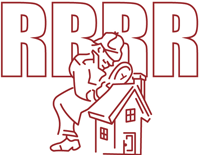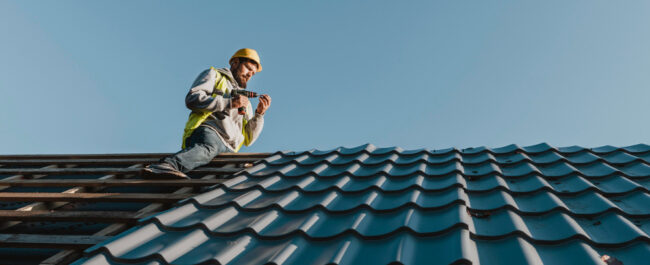Tips for Identifying Potential Roof Leak Issues in Brisbane
While a roof leak can seem minor, it can lead to water damage, mould, and structural issues if left unaddressed. Identifying potential roof leak issues early can help you avoid costly repairs and damage to your home.
So how do you identify potential roof leaks? There are eight main ways that you can identify potential roof leak issues in Brisbane.
1. Check for water stains and discolouration
Checking for yellow or brown water stains and discoloration on your ceiling is important because it can be a clear indication of a potential roof leak.
When water leaks through your roof and into your home, it can cause damage to your ceiling, walls, and even your floors, and there is a good chance by the time you see these marks, damage has already occurred. If left unaddressed, the water can lead to mold growth, which can be hazardous to your health.
By identifying water stains and discoloration early, you can investigate the cause of the leak and address it promptly, preventing further damage to your home and keeping your family safe.
2. Inspect your roof space
Your roof space is the first point of entry for water into your home. If left unchecked, water leaks can cause significant damage to your roof structure, insulation, and even your electrical wiring. By regularly inspecting your roof space, you can catch potential leaks before they cause significant damage and address them promptly. This can save you time and money in costly repairs, as well as prevent potential health hazards such as mold growth.
It is recommended to inspect your roof space at least once a year, especially after heavy rains or storms and this can be done by simply opening any manhole covers in your ceiling, and taking a look around for any damage.
3. Look for missing for damaged tiles
Regularly checking for missing or damaged roof tiles is important to maintain the integrity of your roof and prevent potential leaks. Missing or damaged tiles can expose the underlayment and allow water to seep through your roof, causing damage to your home’s interior and structure.
By inspecting your roof tiles regularly, you can identify and replace any missing or damaged tiles, ensuring that your roof is properly sealed and protecting your home from water damage.
It is recommended to inspect your roof tiles after heavy rain or windstorms, as these events can loosen or displace tiles.
4. Check for cracked or damaged flashing
Flashing is a thin material that covers the seams and joints of your roof, providing a barrier against water infiltration. Damaged or missing flashing can result in water seeping into your home.
Inspecting your flashing regularly allows you to identify any damage or missing pieces and have them repaired or replaced promptly. This will ensure that your roof is properly sealed and that water is directed away from your home.
5. Check your gutters and downpipes
Gutters are designed to collect and direct rainwater away from your roof and the foundation of your home. They can easily become blocked with leaves, debris, or other material, resulting in them unable to properly drain water. This can lead to water overflowing onto your roof and into your home, causing damage to your walls, foundation, and landscaping.
In addition, clogged gutters can also become heavy and pull away from your home, potentially causing damage to your roof and gutter system.
Regularly checking and cleaning your gutters can prevent these problems, ensuring that rainwater is properly directed away from your home.
6. Investigate any unusual noises coming from inside the house
Water dripping sounds can often indicate that water is penetrating your roof, often through a crack in the tiles which you may not spot. Being alert to any water dripping sounds in your roof, can prevent further damage to your home and keep your family safe.
If you hear water dripping sounds in your roof, it is recommended to have a professional inspection to identify the source of the problem and take appropriate action.
7. Be aware of weather conditions
Heavy rain, high winds, and hail can all damage your roof and make existing leaks worse. Extreme temperatures can also cause your roof to expand and contract, leading to cracks and leaks. By monitoring weather conditions and being alert to potential problems, you can take appropriate action to protect your home from further damage. This may include covering any exposed areas of your roof, sealing gaps or cracks, or reinforcing any weak points.
8. Have regular inspections done by professional contractors
Regular roof inspections are important to maintain the health and longevity of your roof, and to prevent potential problems from becoming more serious. A professional roof inspection can identify any issues with your roof, including leaks, damage, or wear and tear.
In addition, regular inspections can help to prolong the life of your roof, saving you money in costly repairs or replacement. A professional roofing contractor can provide a thorough inspection, and identify any potential problems, allowing you to take action to address them before they become more serious.
It is recommended to have your roof inspected at least once a year, and after any major weather events such as hail storms. By being proactive and taking care of your roof, you can ensure the safety and longevity of your home.
Identifying potential roof leak issues early can help you avoid costly repairs and damage to your home. By following these tips, you can stay ahead of any potential problems and keep your home safe and dry. If you do notice any potential issues, be sure to address them promptly to prevent further damage.
If you’ve discovered leaks in your home, contact the team at Brisbane Tile Roof Restorations for an inspection today.

